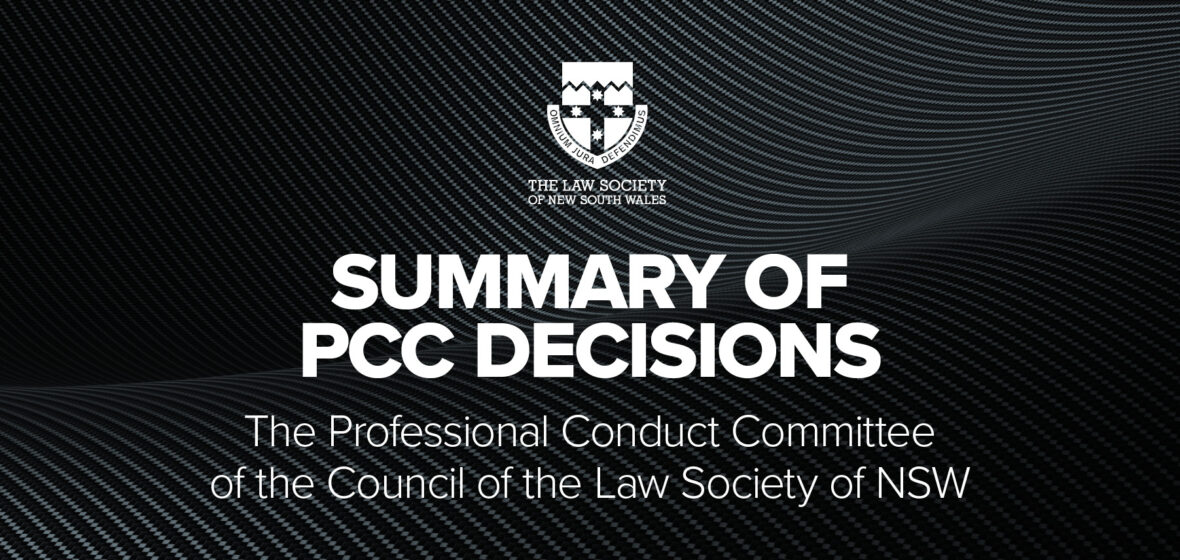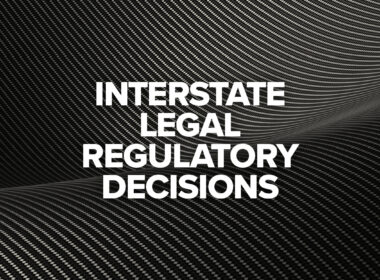The Professional Conduct Committee (PCC) of the Council of the Law Society of NSW (Council), under delegation from the NSW Legal Services Commissioner and the Council, deals with complaints referred to the Council by the NSW Legal Services Commissioner. A total of 98 matters were finalised during the October – December 2024 Quarter.
There were two disciplinary matters determined this quarter, which involved the following conduct issues:
- Contacting another solicitor’s client directly; and
- Failure to deposit money received from a client into the Practice’s trust account.
Contacting another solicitor’s client directly (Rule 33)
One of the matters this quarter concerned the application of Rule 33 of the Legal Profession Uniform Law Australian Solicitors’ Conduct Rules 2015. Rule 33 provides that a solicitor shall not communicate about the subject of the representation with a person the lawyer knows to be represented by another practitioner unless-
33.1.1 the other practitioner has previously consented,
33.1.2 the solicitor believes on reasonable grounds that
(i) the circumstances are so urgent as to require the solicitor to do so, and
(ii) the communication would not be unfair to the opponent’s client,
33.1.3 the communication is solely to enquire whether the other party or parties to a matter are represented and, if so, by whom or
33.1.4 there is notice of the solicitor’s intention to communicate with the other party or parties, but the other practitioner has failed, after a reasonable time, to reply and there is a reasonable basis for proceeding with the communication.
The PCC first considered the complaint, in particular three communications, and resolved to seek further submissions from both the solicitor and the complainant. Upon the further submissions being received the PCC was still not persuaded that the correspondence fell within an exception in Rule 33.
The purpose of Rule 33 is to reflect a “no-contact” rule, as Riley Solicitor’s Manual (Butterworths) usefully provides: [27,055.10] Rational for the “no contact” rule
The main justification usually cited for the “no contact” rule is to prevent a lawyer from circumventing the protection that legal representation provides an opposing party.
This is reflected in the explanation in Council of the Law Society of NSW v Donnelly [2017] NSWCATOD 34 (at 66):
The usual expectation of any person who appoints an agent to look after their interests is that the agent will handle communications and dealings with those who might wish to deal with them in relation to those interests. Where people involved in a transaction or litigation have engaged solicitors to represent their interests, the solicitors must deal with each other, and not bypass one another and deal directly with the client.
By contacting the Complainant’s client directly, the solicitor breached the above Rule and did so after being asked by the Complainant not to do so. Additionally, the solicitor had acknowledged the Complainant’s requests not to contact the client directly and advised that the client would not be contacted directly, unless the exceptions in Rule 33 applied. Further the solicitor’s submissions did not disclose how such communication fell within the exceptions in Rule 33.
As a result, the Committee considered that two letters sent directly to the Complainant’s client and a phone call directly to the client amounted to unsatisfactory professional conduct and determined that the solicitor be reprimanded and complete ethics training and that the solicitor provide a statement demonstrating their understanding of the ethics training.
Failure to deposit money received from a client into Trust and conduct issues which arise in situations where no legal services are being provided
The other matter considered by the PCC was an allegation that the relevant solicitor received money from a client in cash and subsequently failed to take steps to deposit the money into the practice’s trust account, as well as failing to open a file or notify the practice that the money had been received.
Relevantly the Complainant had approached the solicitor in connection with a prospective visa application. Therefore, in view of section 280(1) of the Migration Act 1958 (Cth), which states that a person who is not a registered migration agent must not give immigration assistance, it was necessary for the PCC to consider whether section 262 of the Legal Profession Uniform Law (Uniform Law) applied in circumstances where the solicitor was performing immigration assistance instead of legal work.
Section 262 states that Chapter 5 of the Uniform Law applies to the conduct of a lawyer or a law practice. Therefore, even if the lawyer was performing work that was not considered to be legal services, such as immigration assistance, that conduct would be captured in the ambit of Chapter 5 of the Uniform Law.
The PCC then turned their attention to the application of section 296 and section 107 of the Uniform Law and Rule 31 of the Legal Profession Uniform General Rules (NSW) 2015 (Uniform Rules).
Section 107 of the Uniform Law requires that, in circumstances where a law practice provides legal services and other services, the practice must disclose to the client whether the services provided are legal services and any other matters specified in Rule 31 of the Uniform Rules, for the purposes of the section.
If a proper disclosure has not been made under section 107, the standard of care owed by the law practice in respect of the service is the standard that would be applicable if the service were a legal service that had been provided by an Australian legal practitioner.
Based on their reading of those provisions the PCC considered that it was open to them to find that the solicitor had engaged in unsatisfactory professional conduct in circumstances when the conduct was not in connection with the provision of legal services.
Further, in view of the evidence provided in the complaint, the PCC considered that no disclosure was made under section 107 of the Uniform Law, and that the Complainant considered that legal services were being provided by the practice. This was therefore distinguishable from previous tribunal decisions which considered the previous legislation, which did not include an equivalent to section 107.
As a result of the failure to provide a disclosure, in accordance with section 107, the solicitor was required to provide a standard of care as if the services were a legal service. Additionally, while the money was not trust money, in accordance with section 129 of the Uniform Law (as the money had not been entrusted in the course of the provision of legal services), the standard of care applicable was the same as that applicable to trust money.
The tribunal in the matter of Council of the Law Society of New South Wales v Diaz [2021] NSWCATOD considered a similar matter in which a solicitor drew a cheque for $268, causing the law practice’s trust account to be overdrawn and to remain overdrawn for 137 days. The Tribunal found that the solicitor had engaged in unsatisfactory professional misconduct rather than professional misconduct. They received this decision having regard to the relatively few contraventions which occurred over a “relatively limited period”.
The Committee adopted a similar position and was of the view that the actions of the solicitor amounted to unsatisfactory professional conduct and the solicitor was subject of a reprimand under section 299(1)(b) of the Uniform Law. The solicitor was also fined in the sum of $3,000 in accordance with section 299(1)(f) of the Uniform Law, and the PCC determined that the solicitor complete ethics training.




